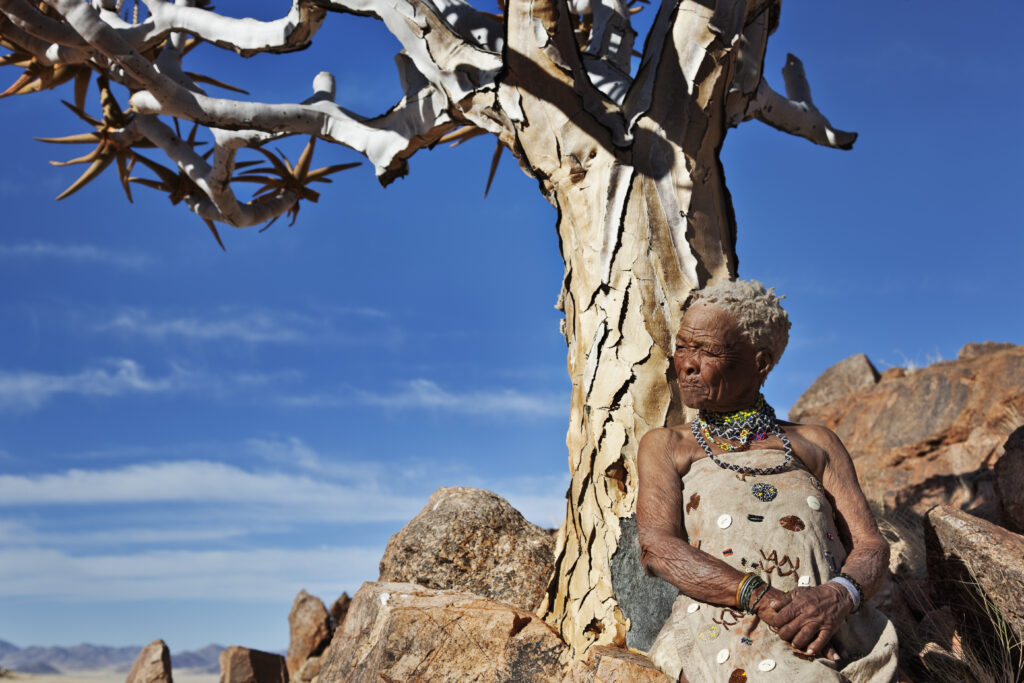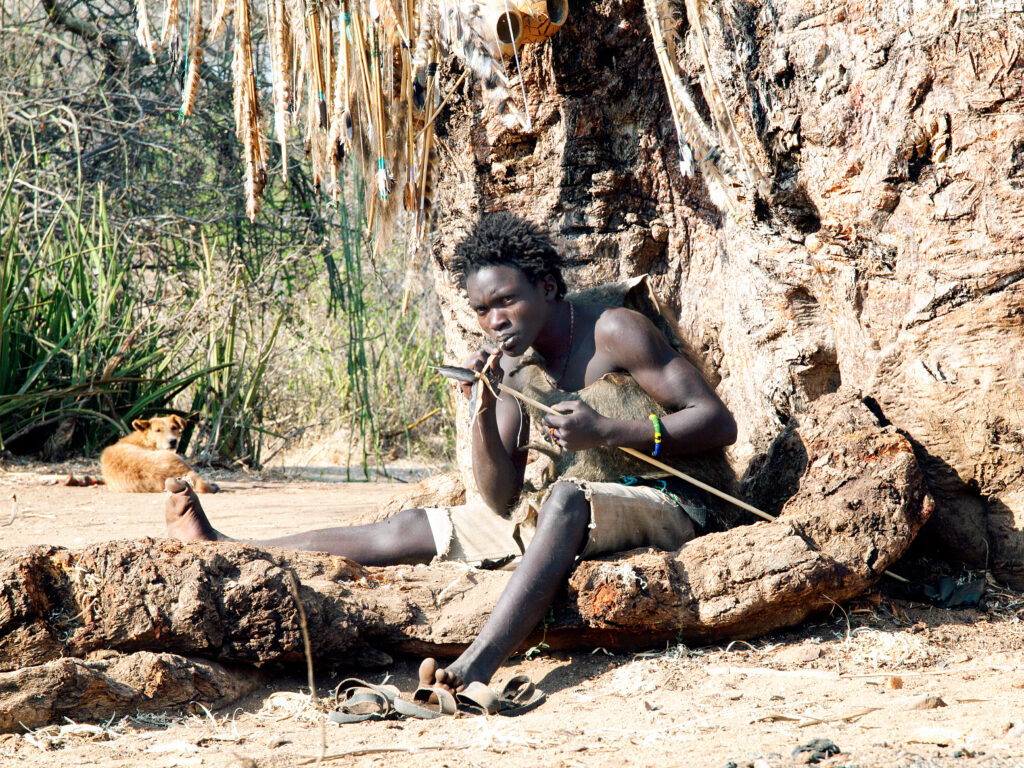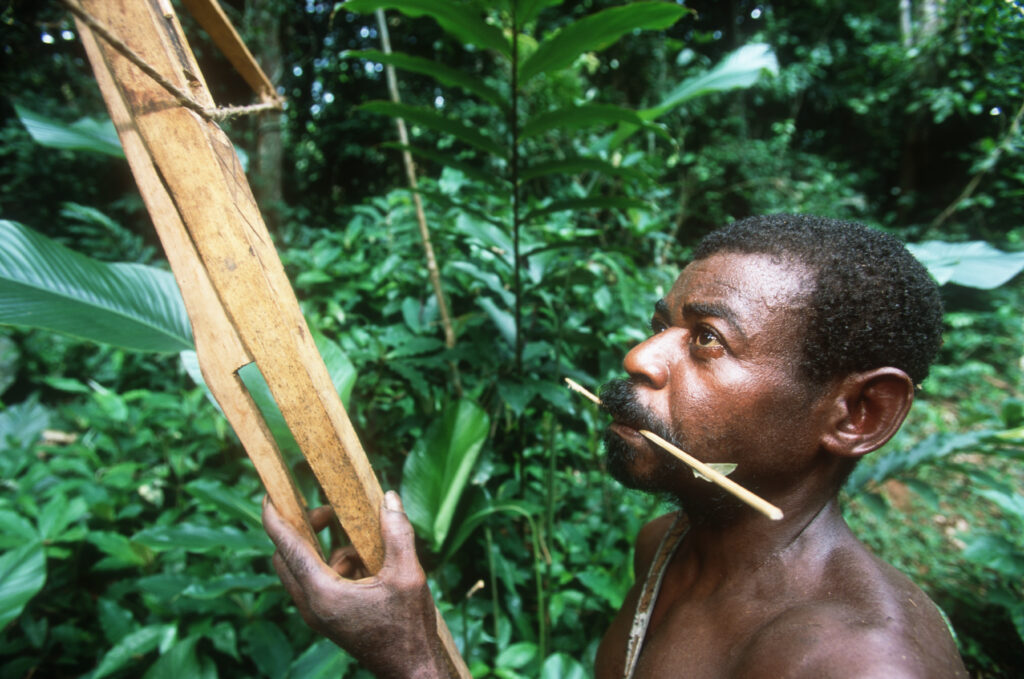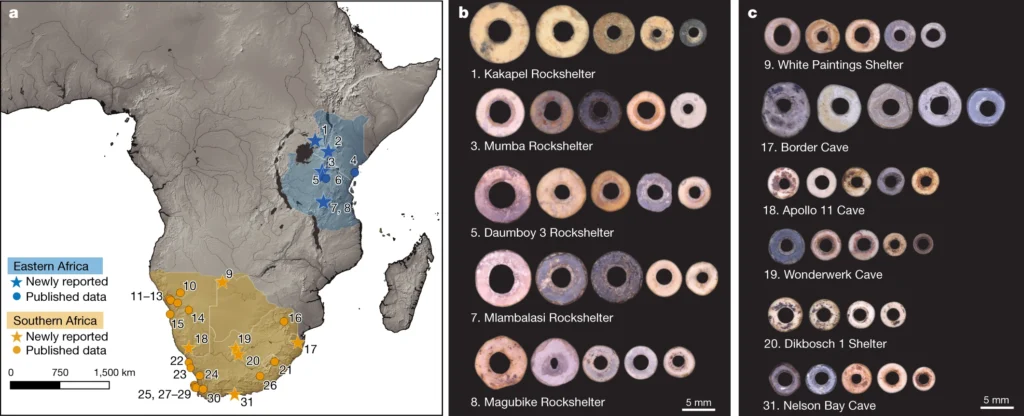New evidence is prompting researchers to rethink Homo sapiens’ origin story—and what it means to be human.

✽
AS A UNIVERSITY STUDENT in the early 2010s, I recall how beautifully simple our origin story was: Homo sapiens evolved in East African savannas around 150,000 years ago. Then, sometime around 70,000 years ago, a mutation occurred that endowed these individuals with the capacity for complex, symbolic behavior. This set them apart from any other species and allowed them to leave Africa and take over the world, replacing all other humans they encountered.
This “East Side Story” made sense, based on major finds in the 20th century. The oldest fully modern H. sapiens skulls, dating to at least 233,000 years ago, were found in Ethiopia’s Omo Valley. “Lucy,” the 3.2-million-year-old Australopithecus afarensis, was also unearthed in Ethiopia. The earliest stone tools, dated to 3.3 million years old, were discovered in Kenya.
East Africa’s ecology presented a straightforward explanation for the human origin story: The region’s system of rift valleys—patched with varied types of environments—famously promote the diversification of mammal, bird, and amphibian species. So, for decades, there was no controversy in suggesting this biodiversity hotspot was the cradle of humankind.
The notion that humans arose in East Africa prompted ideas like the “savanna hypothesis,” which posits that human traits such as bipedalism and big brains were adaptations to living in the region’s grasslands. At the same time, the Hadza—one of the few remaining hunter-gatherer populations in East Africa—became known in the media for offering a “glimpse of what life may have been like before the birth of agriculture 10,000 years ago.”
However, more recent discoveries have shaken up the East Side Story. Accumulating fossil evidence suggests that early H. sapiens populations were inhabiting radically different African regions, ranging from rainforests to deserts. Meanwhile, genetic studies and archaeological evidence are unveiling vast social networks connecting these ancient African societies. This evidence for a pan-African origin of H. sapiens is coalescing into a fascinating story that forces us to rethink what it means to be human.
CONTENDERS FOR THE “CRADLE OF HUMANKIND”
Starting in the early 2000s, groundbreaking findings began to shift humankind’s origin story south. Fossil and archaeological findings uncovered complex symbolic behaviors such as the use of shell beads, pigments, and abstract imagery in the southern corner of Africa. These finds date to hundreds of thousands of years before the hypothesized mutation responsible for the cognitive revolution 70,000 years ago. If our species emerged in East Africa, how can we explain the much earlier appearance of some of its key behaviors in a completely different part of the continent?
DNA studies have turned up even more conclusive evidence for the deep biological history of H. sapiens in Southern Africa. Researchers have sequenced the genomes of ancient and modern African populations, including the San, an Indigenous group of hunter-gatherers living in and around the Kalahari Desert in South Africa, Angola, Namibia, and Botswana. The San were found to have descended from the oldest distinct lineage of H. sapiens. This group split from all other human lineages as early as 350,000 years ago.

In 2017, the plot twisted further. It began with a skull that was recovered in a barium mine west of Morocco’s Atlas Mountains in the early 1960s and was mostly forgotten. The skull possessed some features characteristic of earlier African humans, but overall it looked remarkably modern. Then a team from the Max Planck Institute for Evolutionary Anthropology in Leipzig dated the skull to at least 315,000 years ago, older than any H. sapiens remains. Could it be, then, that our ancient ancestors came from what is now Morocco?
Actually, it gets more complicated.
THE MYSTERY IN THE MIDDLE OF AFRICA
The Congo River Basin in Central Africa is home to the second-largest rainforest on the planet, after the Amazon. It covers over 178 million hectares—more than the area of Alaska. The Congo Basin is also home to the largest and most diverse group of active hunter-gatherers in the world today, comprising a total of 250,000 to 350,000 people. Yet these forested environments have been largely excluded from research into our origins.
Evolutionary tales have traditionally been crafted by weaving one fossil finding with another. But rainforests’ humid, acidic soils rapidly disintegrate fossils—and with them, the material memories of the past. In addition, social and political unrest has often blocked research in the Congo. Plus, the popular conception that our species arose on savannas has led to a mental block against investigating human origins in this tropical ecosystem.
But how, then, can researchers account for the hundreds of thousands of hunter-gatherers currently inhabiting the region? Previously, many scientists assumed they represented marginalized populations that had only recently been displaced to areas where the climate was too harsh for agriculture, so they turned to hunting and gathering in order to survive.
But it’s not a good idea to let scientific theories rest on assumptions. The strategic position of the Congo Basin, lying at the heart of the continent, means it acts as a bridge between the north, south, east, and west. Is it possible this region holds secrets regarding the relationships between the seemingly unrelated early H. sapiens findings in different parts of the continent? And could local hunter-gatherers help unveil such secrets?

In 2020, a group of researchers extracted ancient DNA from the skeletons of four hunter-gatherer children buried between 3,000 and 8,000 years ago in a cave in present-day Cameroon, which borders the Republic of the Congo. The DNA showed that the children were very closely related to today’s Congo Basin hunter-gatherers but not to the farming populations inhabiting the region. This suggests the ancestors of contemporary hunter-gatherers inhabited Central African rainforests long before the first farming expansions.
Moreover, my research group at the University of Zurich published a paper in 2022 that overlaid genetic and archaeological data onto reconstructions of Central African environments. We confirmed that hunter-gatherers began occupying Central African rainforests at least 120,000 years ago.
Incorporating Central Africa into humans’ evolutionary story is not only essential for capturing the huge array of environments early H. sapiens populations inhabited, but also for understanding how they managed to do so. Which behavioral and anatomical changes allowed them to live in such disparate locations? And which of those seemingly scattered groups contributed to modern human diversity?
THE PAN-AFRICAN SOCIAL NETWORK
Often, our ancient African ancestors are portrayed as living in small, isolated bands scattered across the continent. But our research team has found that Central African hunter-gatherer populations have been interacting with one another since at least 120,000 years ago, even when living on opposite ends of the continent. Although these groups have been geographically separated from one another for thousands of years, we found evidence that they have been interchanging genes and cultural items—particularly musical instruments—all along.
Also in 2022, an analysis of strontium isotopes on ostrich eggshell beads revealed a 50,000-year-old exchange network between Eastern and Southern Africa (which got interrupted about 30,000 years ago). Anthropologists have also noted that a similar long-distance network called hxaro—a system of delayed, reciprocal gift exchanges—still remains in place among contemporary San hunter-gatherers.

In addition, archaeological evidence shows that, around 200,000 years ago, our ancestors were transporting obsidian for stone tools more than 160 kilometers across Eastern Africa. And around 320,000 years ago, they were transporting pigments for decorating objects and bodies across long distances.
The precise purpose of these networks is a subject of debate. But clearly, these systems suggest that modern human cultural and biological diversity emerged as a mosaic rather than a linear process. And that mosaic may have contributed to humanity’s success.
In 2017, a team of anthropologists mapped the social networks of two contemporary hunter-gatherer groups in the Congo Basin and the Philippines. They observed that each group is “partially connected” to non-kin. That is, they are composed of distinct communities in separate locations who interact with one another at variable times.
Next, the researchers simulated the cultural development of a complex plant-based medicine in the real hunter-gatherer networks. They compared this to simulations on artificial “fully connected” networks, where virtual individuals can immediately transmit new information to all other individuals. The researchers found that the real hunter-gatherer networks were much more efficient at developing complex culture.
The reason is that, in the fully connected population, innovations spread one step at a time. But in the real hunter-gatherer networks, the combination of periods of isolation and episodes of connectivity allowed new discoveries to develop in parallel in small clusters. These innovations could then be recombined, ultimately resulting in the much faster creation of complex culture.
People were diverse physically, genetically, and culturally—from the very beginning.
Scientists are starting to realize that what researchers used to see as products of “cognitive revolutions”—such as the widespread shift some 300,000 years ago from clunky, handheld stone tools to more refined blades and projectile points—were probably instances of different populations with distinctive cultural and biological features coming together and recombining their genes and ideas.
This mosaic evolution would explain certain seemingly unexplainable findings. For example, researchers found human fossils in the Democratic Republic of Congo that dated to around 22,000 years ago but physically resembled people living around 300,000 years ago. In Senegal, scientists uncovered 12,000-year-old stone toolkits that could easily be transplanted to a situation 100,000 years earlier.
These finds probably resulted from periods of isolation where different populations in different parts of the continent each developed distinctive cultural and physical adaptations to their local environments. At the same time, instances of connectivity allowed different populations to acquire beneficial traits, behaviors, and technologies from one another, becoming better adapted and more flexible.
AN EVOLUTIONARY PARADIGM SHIFT
This slowly emerging paradigm turns our origin story on its head—again. It implies that early H. sapiens did not, as many assumed, originate as a single, relatively large population that exchanged genes and technologies in a more or less random fashion and gradually expanded across and outside of Africa.
African stone tools and other objects have extremely clustered distributions through time and in space. Over time, researchers do see a trend toward more sophisticated material culture, but this “modernization” didn’t originate in one region or occur at one time period. That suggests it was the product of recombination.
DNA extracted from ancient African foragers over the past 10,000 years also tells a story of cycles of connectivity and isolation. Genetic analyses reveal, on the one hand, lineages that have remained distinct since almost 300,000 years ago. On the other hand, the DNA shows levels of genetic diversity indicating that seemingly isolated groups were actually embedded in huge social and mating networks.

These interactions would have prevented the dangerous effects of inbreeding, allowing our ancestors to thrive even when tough conditions made it difficult to maintain larger populations. Greater genetic diversity also meant a larger reservoir of potentially beneficial mutations that could give populations a greater ability to adapt to challenges in different environments.
Future work will help determine why human groups were so divided and what conditions made their confluence possible at certain times. But what is clear now is that our immediate H. sapiens ancestors lived across the African continent. People were diverse physically, genetically, and culturally—from the very beginning.
H. sapiens is neither a savanna nor a rainforest species. We are not wholly carnivorous or herbivorous, peaceful or war prone. We did not descend entirely from the Hadza or San lineage, because there was never one “ancestral human population.” We are a rich blend of many groups that have lived in extremely diverse environments for thousands of years.
Perhaps, then, H. sapiens’ quintessential adaptation is to exchange ideas, genes, and culture with one another. In doing so, humans have developed beautifully complex and dynamic behaviors, beliefs, and technologies that have allowed us to thrive wherever we have traveled.

helloI like your writing very so much proportion we keep up a correspondence extra approximately your post on AOL I need an expert in this space to unravel my problem May be that is you Taking a look forward to see you